Green marketing is like a salad 🥗: everyone knows it’s healthy, but does it taste good? Companies have understood that this notion is important for the consumer. Come on, let’s see how to get into this strategy without falling into greenwashing 🟢. To give you a taste of our salad, here is what we will see during this article:
- The definition of Green marketing
- Its stakes. The advantages 💌 to implement it for his company.
- The place of the consumer in green marketing.
- The risks (because there are some).
- How to implement this strategy.
- The examples of companies that have succeeded.
Green marketing: Definition
Green marketing, also known as ecological marketing or sustainable marketing, is a marketing strategy that aims to promote products or services that are environmentally friendly 🍀 and sustainable.
The objective is to respond to the growing concerns of consumers about environmental protection by offering eco-friendly products and highlighting the eco-responsible actions of companies.
Green marketing is not limited to the simple promotion of environmentally friendly products 💓. It can also include the implementation of sustainable production practices, the reduction of greenhouse gas emissions, the implementation of recycling policies or the promotion of the circular economy.
Green marketing is a growing marketing strategy that allows companies to respond to consumers’ environmental concerns while strengthening their brand image. Be careful to put in place truly sustainable practices to avoid greenwashing and to respond to consumer expectations in a transparent manner.
The challenges of green marketing
It is important to know that the stakes of green marketing are multiple and are part of a context of growing awareness 🧠 of the impact of human activity on the environment. Companies wishing to adopt a green marketing strategy must take into account the following issues:
- Consumer demand: They are, indeed, more and more sensitive to environmental issues and are looking for products or services that address their concerns. Green marketing allows companies to meet this demand and to differentiate themselves from their competitors.
- Environmental regulations ♻️: They are increasingly strict, and companies must comply with them to avoid sanctions. Green marketing can therefore be a way to show that your company is in compliance with environmental regulations.
- Cost reduction: Implementing certain sustainable production practices can help you reduce costs and improve profitability.
- Brand image: Consumers are increasingly attracted to companies that care about the environment. This can reinforce your company’s brand image by giving it an eco-responsible dimension.
The benefits of green marketing for companies
As you can imagine, by using this strategy, you can benefit from some advantages such as :
- 🟢 Strengthen your brand image by communicating on your actions in favor of the environment.
- 🟢 Attract new customers: consumers who are sensitive to environmental issues are often willing to pay more for more environmentally friendly products. This can help you attract new customers.
- 🟢 Improve your customer relationship: by involving the consumer in their environmental journey, you can improve your customer relationships by creating an engaged and loyal community.
- 🟢 Reduce costs : You can implement sustainable practices and reduce your costs by optimizing your energy, water or raw material consumption.
- 🟢 Differentiate yourself from the competition: by offering green products or services, you can differentiate yourself and stand out.
- 🟢 Contribute to the preservation of the environment: this is the most important point. There is a lot of talk about climate change, there must be companies that are also concerned. By contributing to actively preserve the environment, you encourage other people or companies to do the same.
What is Green Communication?
As you can imagine, when you embark on an environmental marketing campaign, your speech must also follow. This is called “Green communication” or green communication if you prefer.
We realize that the brands hold speeches in which they will place certain terms such as:
- Sustainable.
- Environmental.
- Ethical.
- Natural.
- Eco-responsible.
It’s the way you turn your marketing discourse that makes you “green communication” or not.
Consumers and green marketing
The consumer plays a key role 🗝️ in the adoption and development of green marketing. Indeed, more and more consumers are looking to buy sustainable and environmentally friendly products. This is a good thing since green marketing responds to this growing demand.
However, consumers are also increasingly aware of greenwashing and have become more skeptical about companies’ sustainability claims. They now want tangible evidence that products are actually sustainable, and are willing to research and compare different brands to find products that meet their sustainability expectations.
Green marketing can therefore offer an opportunity 💡 for companies wishing to differentiate themselves and it allows them to meet consumer expectations on that level. However, to be successful, it is essential to communicate transparently and honestly, provide tangible evidence of product sustainability and engage in real sustainability practices.
The risks of greenwashing
In case you want to do greenwashing, we strongly advise you not to do it since you risk :
- 🔴 Lose the trust of your consumers: They could feel cheated if you use greenwashing practices. This would then lead to a loss of trust in the company as well as a decrease in sales 📉.
- 🔴 Lowering your company’s reputation: Hey yes, you can damage your reputation, especially if you are exposed by the media or environmental protection organizations.
- 🔴 Suffer regulatory penalties: Advertising and consumer protection regulations may prohibit the use of green or misleading terms in your marketing communication. As a result, companies that use greenwashing practices may incur penalties.
- 🔴 Negatively impacting the environment: By using greenwashing practices, you are making your consumers believe that you are taking steps to protect the environment when in reality you are not. This can lead to an increase in the company’s negative environmental impacts.
As you can see, greenwashing is a risky practice for companies, which can lead to a loss of consumer confidence and sanctions. Stay transparent and honest so as not to lose this.
How to set up a green marketing strategy?
Implementing a green marketing strategy involves taking concrete steps 📏 to reduce your company’s environmental impact while transparently and effectively communicating those steps to your consumers. We’ll list some key steps.
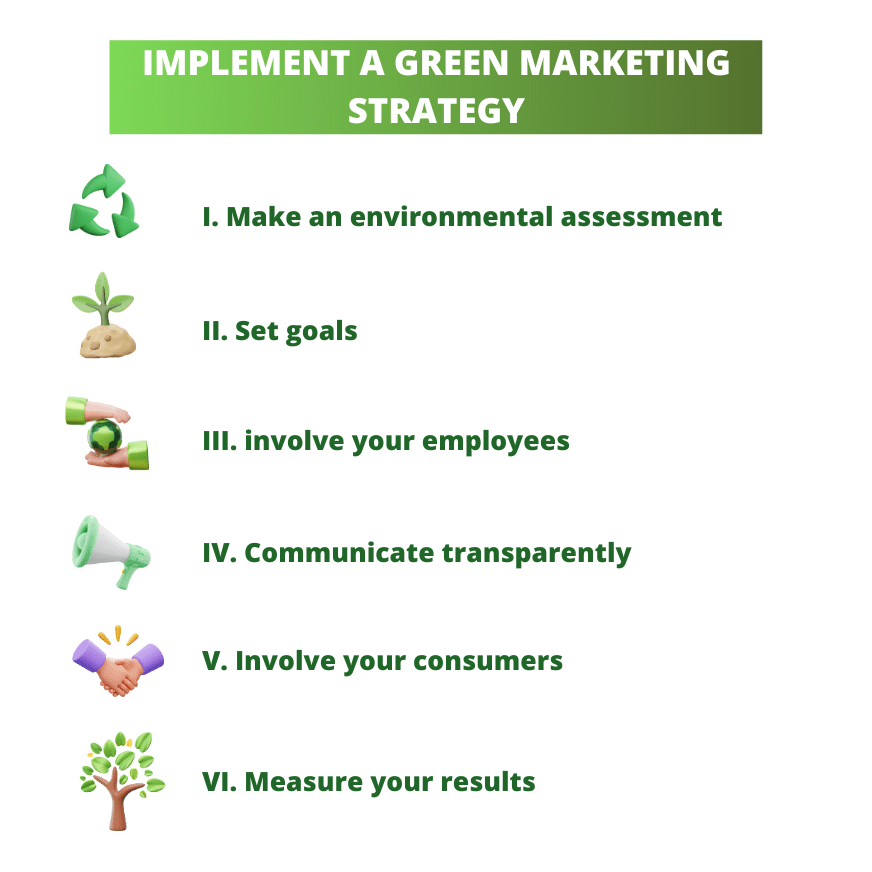
I. Conduct an environmental assessment
In order to know where you stand, don’t hesitate to do an environmental assessment.
- What is the environmental impact of my product or service?
- How can I reduce my carbon footprint?
- Can I turn to suppliers
This will help you identify areas where you can reduce your impact and what actions you can take.
II. Set Goals
Once you have assessed your impact, you can set goals for reducing it. Make sure that these goals are measurable, realistic and achievable. You may want to use the SMART goal method.
III. involve your employees
The success of your green marketing strategy will also depend largely on the involvement of your employees ❤️. Make sure they understand the environmental issues and the objectives of your company or project in terms of sustainable development.
IV. Communicate clearly and transparently
For your green marketing strategy to work, you will need to communicate your sustainability actions and results transparently. Use relevant communication channels to reach your audience. Here, it is crucial to know your audience well 🎯. This will allow you to adapt your strategy according to the social network you will use.
V. Involve your consumers
You should not hesitate to inform your consumers about your actions regarding sustainable development and encouraging them to adopt more sustainable practices. You can draw inspiration from the examples we will talk about after 👇.
VI. Measure your results
There is no point in setting goals if you do not measure them afterwards. When you launch actions, you want them to be successful. So you’re going to have to track some of your KPIs. Our advice is to measure the results of your actions. Use relevant measurement tools to track your progress and adjust it if necessary.
5 Examples of successful green marketing
To help you better understand how to successfully implement green marketing, what better way than to tell you about the brands that have shone in this field?
Patagonia
Patagonia is an American outdoor clothing company that has become an example of successful green marketing. You’re probably wondering why? Don’t worry, we’ll explain.

Since its inception in 1973, the company has been committed to producing sustainable and environmentally friendly clothing ♻️.
Patagonia uses transparent and honest communication to educate consumers about environmental issues and encourages sustainability among its customers. It also uses a range of sustainable and environmentally friendly materials, including organic cotton, recycled polyester and natural dyes.
It also launched an innovative marketing campaign called “Don’t buy this jacket,” which encouraged consumers not to buy new jackets unless they really needed them. The brand encouraged to repair or recycle their existing clothing 🤯.
This campaign was a real success ✅ as it allowed the company to raise awareness of environmental issues among consumers while reinforcing the brand ‘s commitment to sustainability. It is a great example of successful green marketing because the company is transparent and honest in its environmental communication, uses sustainable materials, and encourages sustainability in its customers. Consumers are therefore sensitive to this authentic and committed approach.
This is how the company has managed to differentiate itself in a competitive market.
Ecover
If you happen to be shopping and wandering through the household products aisle 🧹 you may have seen products from the Ecover brand. This Belgian company was founded in 1980. This one is committed to producing sustainable and environmentally friendly cleaning products. It uses natural and biodegradable ingredients in its products, such as essential oils, organic acids and enzymes.
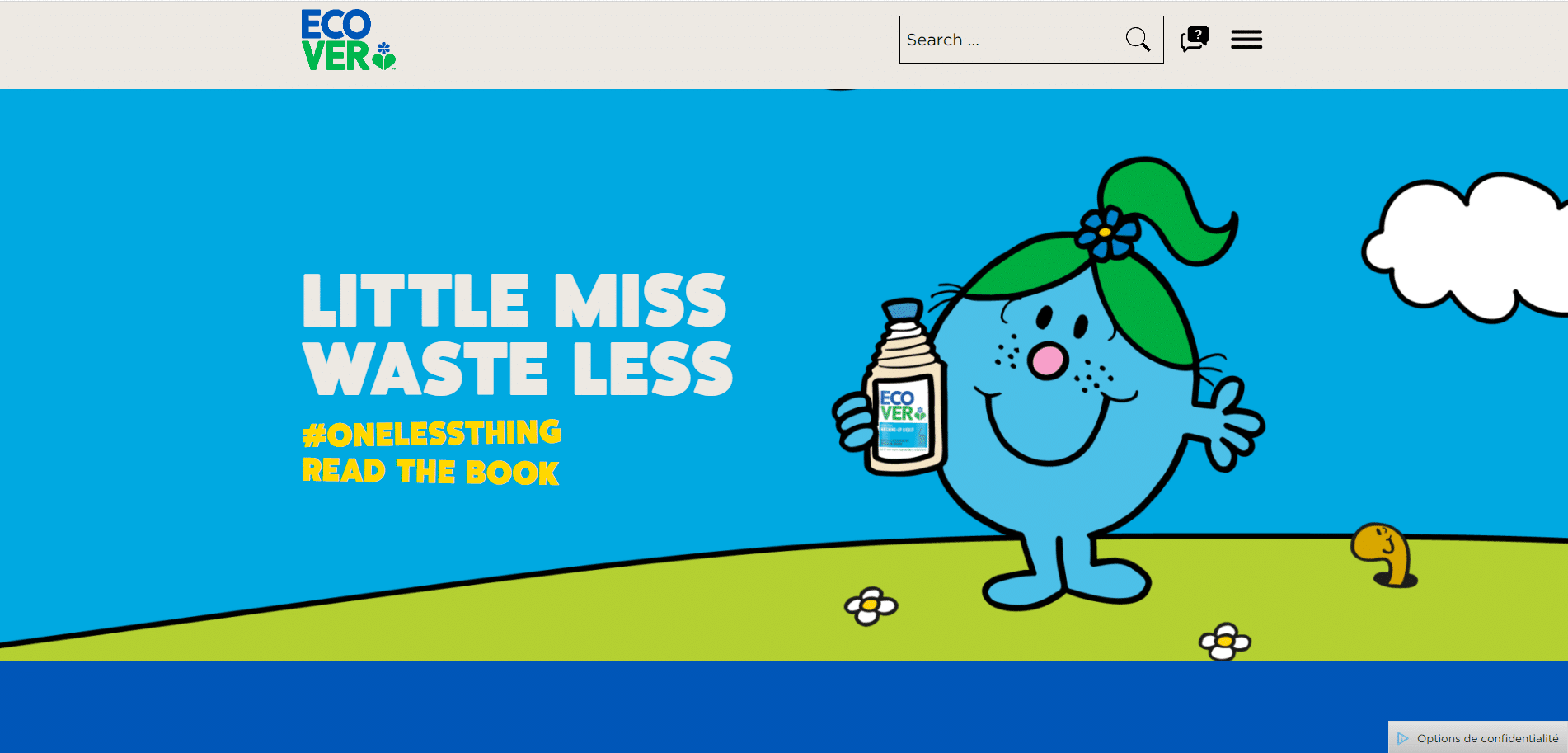
Ecover uses a transparent approach in its environmental communication, including providing detailed information on the ingredients used in its products as well as the production methods used. It also uses educational communication 🧠 to raise consumer awareness of the environmental impacts of traditional cleaning products.
But that’s not all, it launched a marketing campaign called “Message in our bottle,” which aimed to raise consumer awareness of plastic pollution and encourage sustainable recycling practices.
This campaign included a giant art installation of empty plastic bottles, as well as a call to action to encourage consumers to recycle properly.
The Body Shop
The Body Shop is a British beauty products company 💄 that is known for its commitment to sustainability and fair trade. Since its inception in the 1970s, this company has sought to minimize its environmental impact by using natural ingredients and encouraging sustainable practices throughout its supply chain.
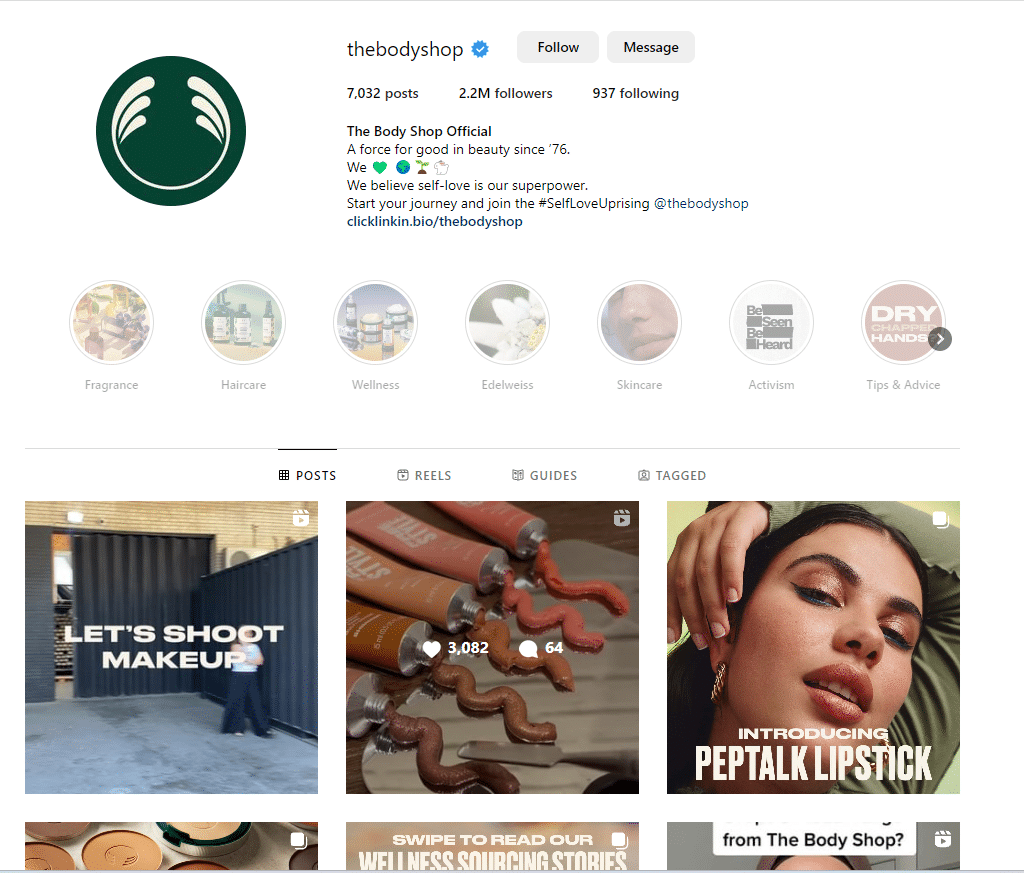
In terms of green marketing, the company uses transparent communication to raise consumer awareness of environmental and social issues related to the beauty industry. For example, the company regularly uses advertising campaigns to promote important environmental and social messages such as:
- Animal welfare 🐈⬛.
- Fair trade.
- Sustainability.
The Body Shop also has recycling programs for its products, as well as sustainability initiatives to reduce the environmental impact of its packaging and operations. This company also uses Fair Trade ingredients whenever possible to support local communities and promote sustainable production practices.
Ikea
It’s impossible to miss this brand. Ikea is a Swedish furniture (with unpronounceable names, by the way) and home decor company. The brand is committed to reducing its environmental impact and promoting sustainable practices throughout its supply chain.
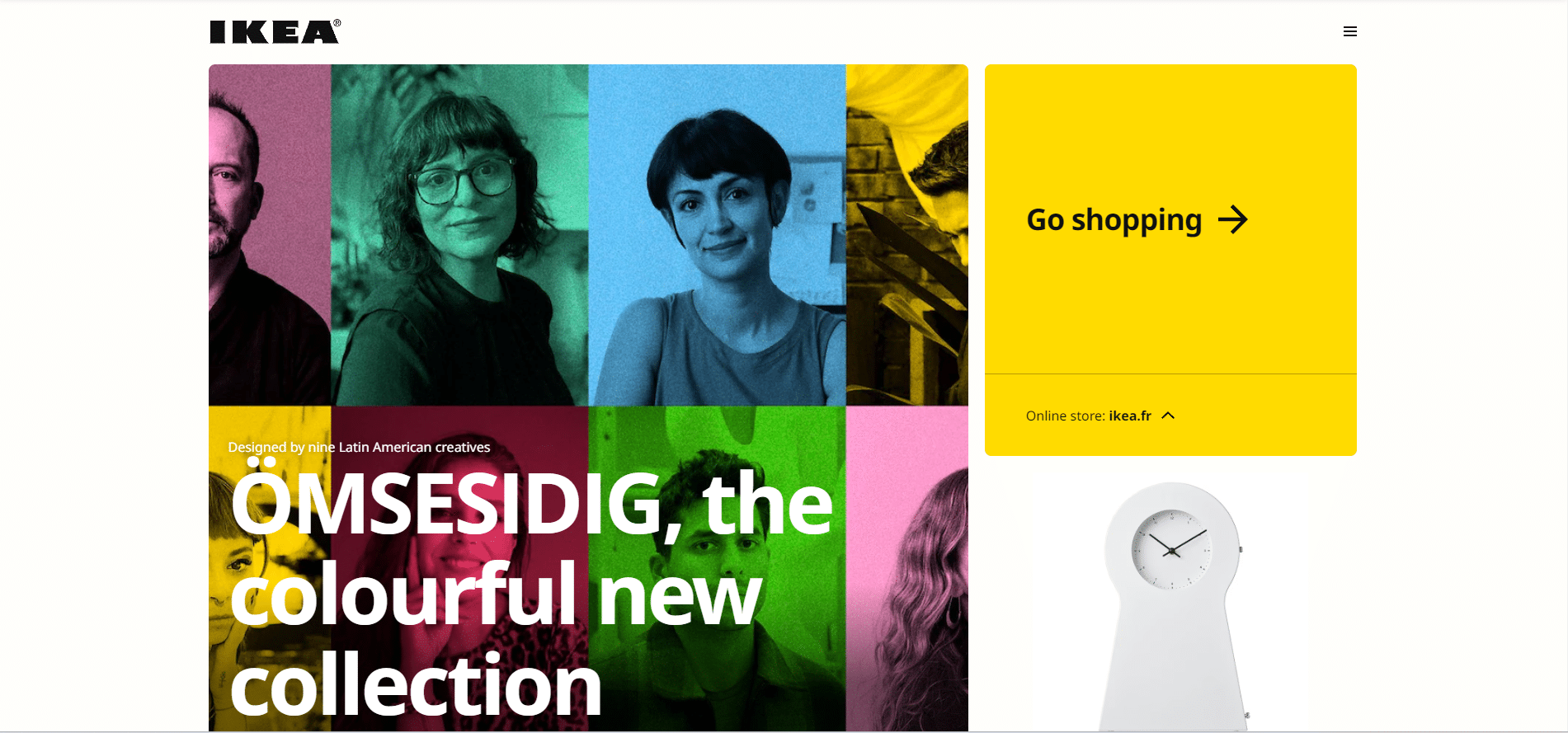
In terms of green marketing, Ikea uses communication to raise consumer awareness of environmental issues related to the furniture industry and encourages sustainability among its customers by offering products made from sustainable and recyclable materials.
Ikea also strives to reduce its carbon footprint 🐾 by adopting sustainable transportation practices, using renewable energy sources and working with sustainable suppliers. It also offers recycling programs for its products and uses recycled materials in the manufacturing of new products.
In addition, Ikea has launched several initiatives to encourage consumers to adopt sustainable living practices. For example, it has launched a “Buy back” campaign to encourage customers to resell their old Ikea furniture for recycling or reuse, thereby reducing waste and carbon emissions.
The company is often cited as a successful example of green marketing in the furniture and home décor industry.
Ben & Jerry’s
To all our little gourmands, we are going to talk about the ice cream brand Ben & Jerry’s.
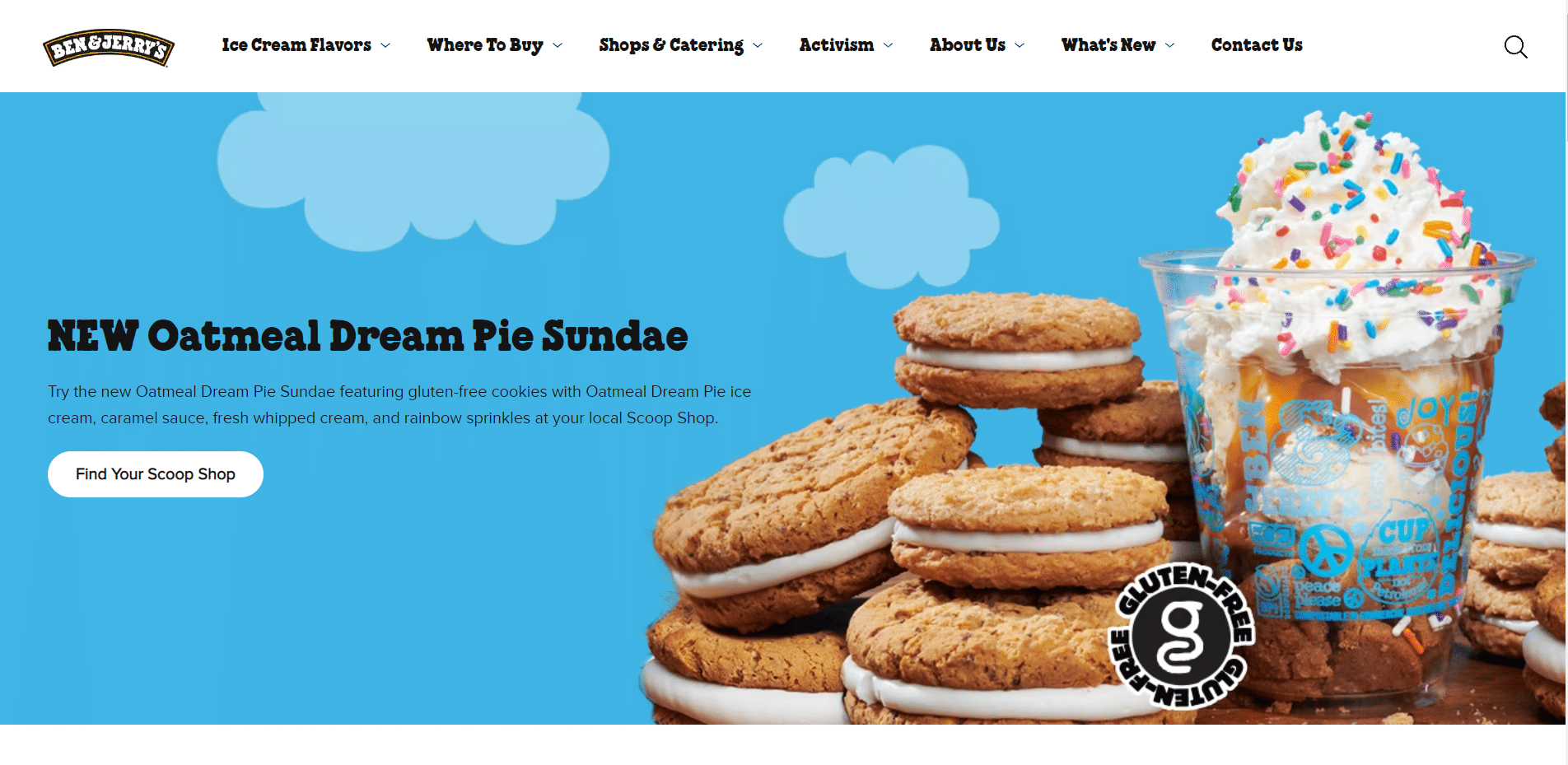
Ben & Jerry’s is an American ice cream company 🍧 known for its commitment to sustainability and social justice (yikes!).
The brand uses completely transparent communication to educate consumers about environmental issues (like the other examples we discussed earlier) related to the food industry to promote its sustainable practices. It sources ingredients from sustainable suppliers and uses biodegradable packaging in an effort to reduce its environmental impact.
It has also launched several initiatives to encourage consumers to adopt sustainable practices, such as the “Climate Justice Challenge” which encourages people to reduce their carbon footprint. The brand uses its platform to advocate for social and political causes, such as migrant and refugee rights, gender equality and racial justice.
The company has also created a foundation to support social and environmental justice projects around the world.
Conclusion
We’re coming to the conclusion of this article 😔 and believe us, it breaks our hearts to have to say goodbye. However, we’re going to remember what we’ve seen throughout this article. In order to boost your marketing strategies, you can totally go green, so green marketing. This type of strategy, as a marketer, can help you improve your sales, acquire new prospects and build customer loyalty.
We have seen the definition of green marketing, its stakes, the advantages for companies as well as different examples. It’s up to you to experiment and make it work 🤩.
Article FAQ
Before we leave each other for good, you are entitled to the little notions that come with our topic. It’s over here 👇.
Green marketing def
In order not to lose the thread, let’s go over the principles of green marketing. Green marketing, ecological marketing or green marketing is a type of marketing that will allow a brand to make an ecological positioning as a selling point.
These companies can communicate on their environmental actions ♻️ in order to enhance their brand image. There are many advantages to put this type of marketing in place since you will have the opportunity to strengthen your links with your existing targets, to acquire new customers and even in some cases, to reduce your costs.
What is greenwashing?
We talked about it a lot during this article but finally, we don’t know exactly what it is. Don’t panic, it’s about to change. In fact, greenwashing is a deceptive marketing practice that consists in presenting a product or a company as environmentally friendly without it really being the case.
Companies often use terms such as”green”, “organic”, or “sustainable” to attract environmentally conscious consumers. Except that these terms are sometimes misused, without the company’s products or practices actually being sustainable or environmentally friendly.
Greenwashing can lead to a loss of consumer confidence in companies that use these deceptive practices and a negative perception of the entire sustainability movement.
That’s the end of the end, but at least you now know what green marketing is all about.









